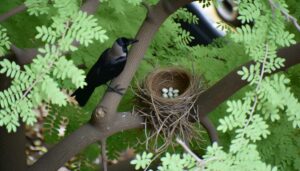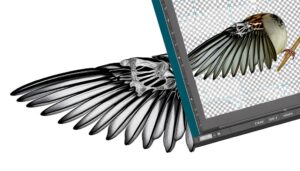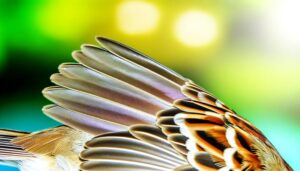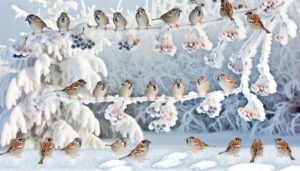Effective Ways to Keep Sparrows Away From Your Bird Feeder
To deter sparrows from bird feeders, employ weight-sensitive perches and tube feeders with narrow ports. Offer sunflower hearts and safflower seeds while avoiding millet.
Consider using caged or dome-shaped feeders. Utilize physical deterrents such as mesh cages, and auditory ones like ultrasonic devices.
Place feeders at 10 feet from dense shrubbery and 5-7 feet high in well-lit, open areas to minimize sparrow visits. Adjustable perch distance can also help.
These strategies, grounded in scientific research, will discourage sparrows and attract desired birds. For a deeper insight into effective sparrow deterrents and feeder optimizations, continue exploring evidence-based methods.
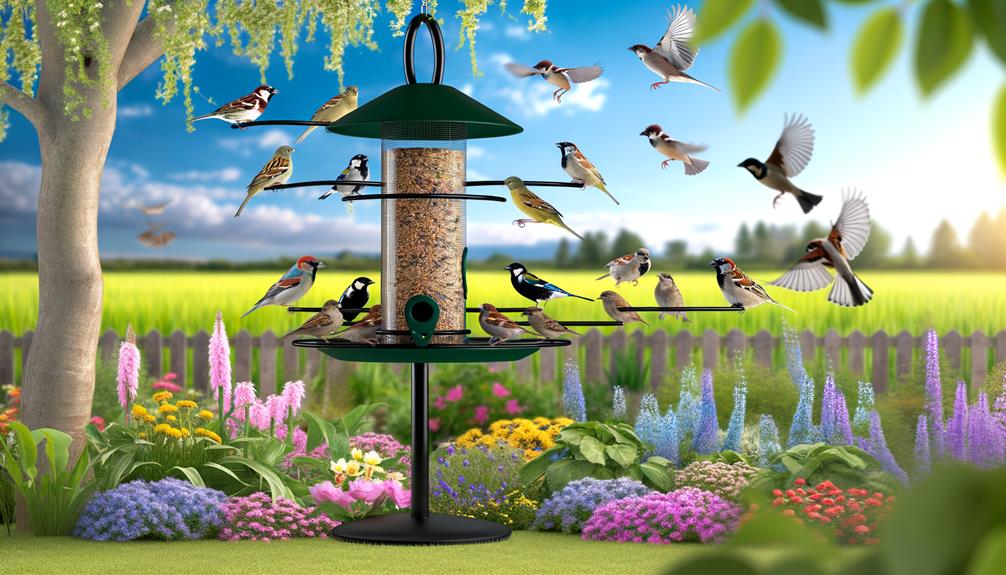
Key Takeaways
- Use weight-sensitive feeders that close off access when heavier birds like sparrows land.
- Select feeders with small perches and narrow ports, making it difficult for sparrows to feed.
- Opt for seeds like sunflower hearts and safflower, which sparrows find less appealing.
- Install physical deterrents such as mesh cages or reflective tape to make feeders less accessible to sparrows.
- Place feeders in open, elevated areas, avoiding dense shrubbery and nesting sites to discourage sparrow visits.
Choose the Right Feeder
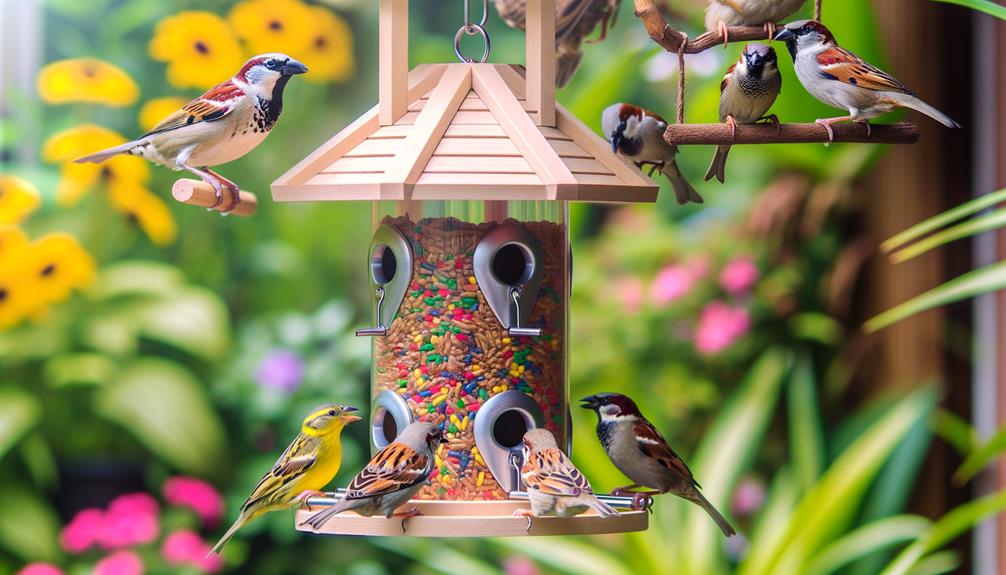
Selecting an appropriate bird feeder is essential in minimizing the presence of sparrows, as certain feeder designs can effectively deter these ubiquitous birds while accommodating desired species. Research indicates that feeders with weight-sensitive perches can exclude lighter sparrows by closing access to food when they land.
Tube feeders with small perches and narrow feeding ports are also effective, as these designs favor species with specialized feeding behaviors, such as finches and chickadees. Dome-shaped feeders, often referred to as 'squirrel baffles,' can be adjusted to restrict larger birds, including sparrows.
Additionally, feeders with mesh designs can limit access to smaller birds while allowing larger, desired species to feed comfortably. Employing these feeder designs can notably reduce sparrow visitation.
Select Specific Bird Seeds
Research demonstrates that certain types of bird seeds can significantly influence the species composition at feeders, effectively reducing the attraction for sparrows while promoting the presence of more desired birds. Significantly, sunflower hearts and safflower seeds are less appealing to sparrows but highly favored by cardinals, finches, and chickadees.
Studies indicate that sparrows display a preference for smaller seeds such as millet, which can be minimized or excluded from the feeder mix to deter their presence. Additionally, nyjer (thistle) seeds attract finches but are generally ignored by sparrows.
Implementing these specific seed choices can strategically alter the feeding dynamics, thereby creating an environment less conducive to sparrow dominance while fostering a more diverse avian population.
Install Sparrow Deterrents
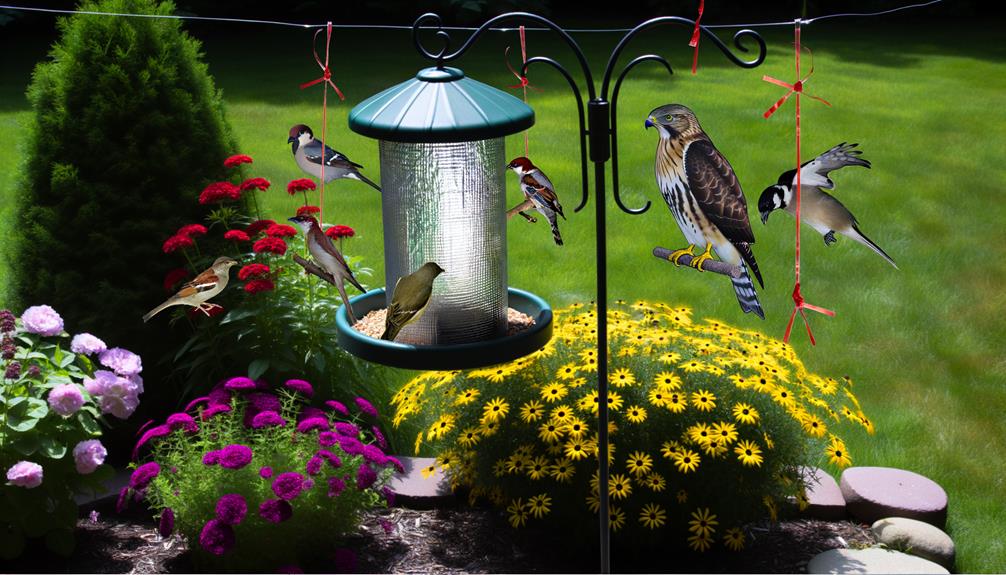
Regularly implementing physical barriers and auditory deterrents can greatly reduce sparrow activity around bird feeders.
Physical barriers such as mesh cages with small apertures can be effective, as they allow access to smaller desired species while excluding larger sparrows.
Auditory deterrents, including ultrasonic devices, exploit sparrows' aversion to certain frequencies. Research indicates that sparrows are sensitive to high-frequency sounds, causing them to relocate.
Visual deterrents, like reflective tape or predator decoys, can also be employed to create an environment perceived as hostile. Additionally, motion-activated sprinklers introduce an element of unpredictability, further discouraging sparrows.
It is essential to periodically alter these deterrents to prevent habituation, ensuring sustained efficacy in mitigating sparrow presence around bird feeders.
Optimize Feeder Placement
Positioning bird feeders strategically can significantly influence sparrow visitation rates by minimizing their access while maximizing the attraction of desired species.
Research indicates that placing feeders at least 10 feet away from dense shrubbery or low-hanging branches reduces sparrow congregation, as these locations offer less cover and perching opportunities.
Additionally, elevating feeders to a height of 5 to 7 feet can deter ground-feeding sparrows while accommodating species that prefer mid-level feeding.
Observational studies suggest feeders positioned in open, clear areas with sufficient distance from nesting sites are less frequented by sparrows.
Ensuring feeders are placed in well-lit locations can also discourage sparrows, as they tend to avoid areas with high light exposure due to increased predation risks.
Use Sparrow-Proof Feeders
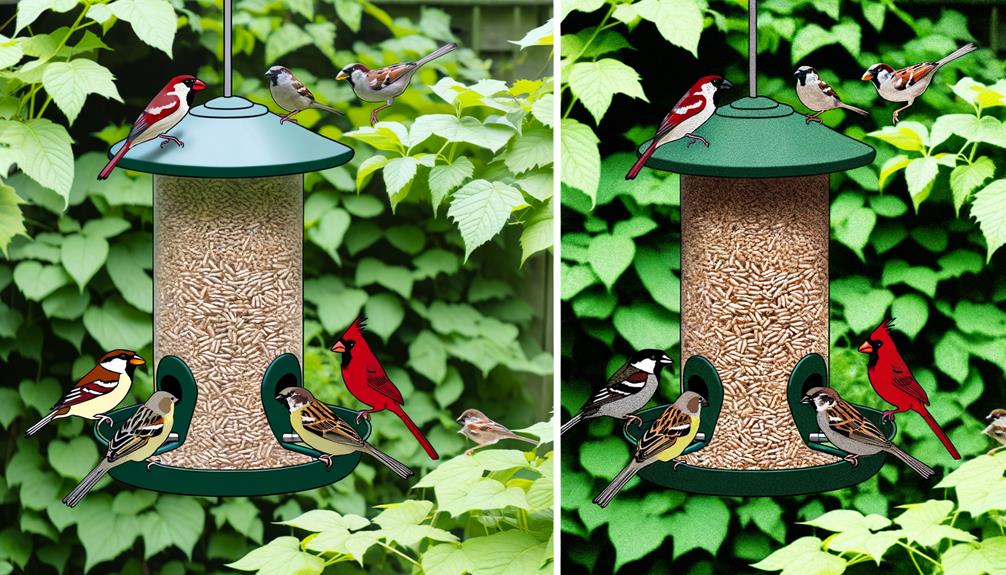
Implementing sparrow-proof feeders can effectively reduce sparrow activity at bird feeding stations. This can be achieved by utilizing design features that selectively allow access to desired bird species. Research indicates that feeders designed with specific entry dimensions, weight-sensitive perches, and tailored feeding ports can deter sparrows while accommodating preferred avian species.
Detailed observations have shown that sparrows are less likely to frequent feeders with the following attributes:
- Caged feeders: Mesh enclosures that permit smaller birds while excluding larger sparrows.
- Weight-sensitive feeders: Mechanisms that close feeding ports when heavier birds, such as sparrows, land.
- Tube feeders with small ports: Designed for species with smaller beaks.
- Feeding ports below perches: Discourages larger birds that cannot maneuver.
- Adjustable perch distance: Customizable to exclude sparrows based on their size and feeding behavior.
Conclusion
To sum up, the implementation of strategic measures to mitigate sparrow presence at bird feeders can be highly effective.
Utilizing specialized feeders, selecting specific seed types, and incorporating deterrents are crucial to this endeavor.
Additionally, ideal feeder placement and the use of sparrow-proof designs further enhance the efficacy of these interventions.
Through meticulous adherence to these scientifically-supported practices, the goal of minimizing sparrow interference while promoting the well-being of desired avian species can be achieved.


